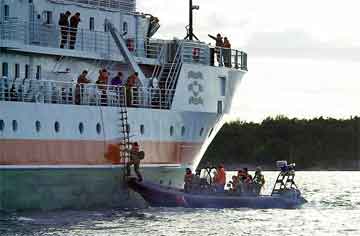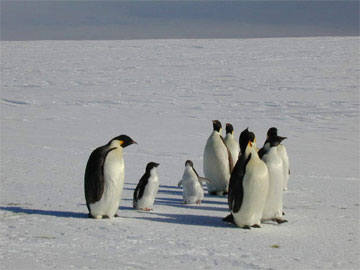|
The Finnish Institute of Marine Research, our new neighbours
Visitors entering Dynamicum are met by an eight-metre column with a light showing the current wave height on the Baltic Sea. The information is submitted directly from the wave buoy of the FIMR. The height of the column is not quite enough to show the most severe storms, since the record wave heights in the Baltic run up to 14 metres – to show these, the column would have to reach the ceiling of Dynamicum. The FIMR moved to Kumpula from Itäkeskus in September/October. The staff of the FIMR consists of around 130 employees: mainly biologists, physicists, chemists, and even a few mathematicians and geographers. In addition, the institute employs some technical staff at the Dynamicum workshop, to repair, modify and build different research instruments. How to study the sea The FIMR is governed by the Finnish Ministry of Transport and Communications, and its mission is to produce scientific marine information. In addition to applied and follow-up research, the institute carries out theoretical research into ecosystems and currents. The focus is on Baltic Sea research. The institute has its own research vessel, Aranda, which usually travels around the Baltic gathering and studying samples and measurements on the sea water, population and sea bed. Furthermore, the institute arranges expeditions to cold sea areas, i.e. the Spitzbergen and Antarctica. There is an annual expedition to the Finnish Aboa research station on Queen Maud's Land in Antractica, and this summer's service expedition, Finnarp, arrived at the station a week ago. The research objects are not only geographically diverse. The research into sea dynamics and the interaction between sea and atmosphere studies and models the changes in surf and water levels, the processes of currents and mixing, heat balance and ice. As for the research into global marine changes and long-term changes, the goal is to distinguish between changes caused by man and the natural variations in a marine environment. Another spearhead of the institute is the research information produced for commercial shipping needs, detailing informing on water levels, surf and ice conditions, and expanded to include predictions on the same. Many of us are familiar with the broadcasts on the algae situation, and many of us have taken a trip on one of the ships that gather samples for this information. In addition to freight vessels and Border Guard ships, Silja Opera, Silja Serenade and Romantika, among others, gather these samples. The institute's main partners at the university are physicists, chemists and some bio-scientists. That important question for us at Exactum How can we eat at the restaurant in Dynamicum, since it is behind closed doors? You only have to fill in a form in the reception, giving the restaurant as your host, and you will be given a visitor's pass. In addition to the restaurant, you can also use the libraries of the FIMR and the Finnish Meteorological Institute, and the collections of the latter are available in Helka. You can gain access to the libraries in the same way, though naming the library as your host, of course. More about the Finnish Institute of Marine Research: http://www.fimr.fi Sanna Kettunen |


